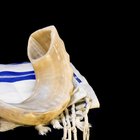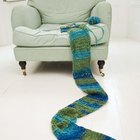
Comstock/Comstock/Getty Images
A Jewish prayer shawl (called a "tallit" in Hebrew or a "tallis" in Yiddish) is an essential ritual accessory for Jewish prayer. During daily morning prayer services, Jewish men (and some Jewish women, depending on the congregation) wrap themselves in a tallit in response to Numbers 15:38–40, which states that Jewish people must wear fringes on the corners of their garments as a reminder of God's commandments.
Design your tallit. Traditional tallitot (the plural of tallit) are made of wool, and have blue or black stripes on a natural or white background, but nowadays you will see a rainbow of colors in the synagogue, especially among women and younger men. Choose a fabric you like, in wool, silk, rayon, or even cotton. Try a solid color for the body of the tallit, and a patterned fabric for accents, such as stripes, reinforcing at the corners, and the atarah. Another option is to embroider decorations onto the fabric.
Cut your fabric to size. Traditional tallitot usually measure 72 or 80 inches long (although feel free to make yours to match the length of your arms from wrist to wrist), and vary in width from 36 inches for a small bar or bat mitzvah child to 72 inches for a tall man. Your tallit should be no wider than the distance from your neck to the back of your knees, and many tallitot are considerably narrower than that. Hem the sides so your fabric does not ravel.
Sew on your accent fabrics or embroider the body of the tallit for decoration. The atarah (Hebrew for crown) is a rectangular band of fabric that is sewn along the top edge of the tallit to show you which end is up. It is often embroidered with the blessing for the mitzvah of tallit on it as a reminder, but can also be merely decorative (try glass or metal beads for an update on the old-fashioned metal atarah your rabbi wore when you were a kid). Reinforce the corners of your tallit with squares of accent fabric, so the tzitzit don't rip the tallit.
Use the buttonhole setting on your sewing machine to create the holes for the tzitzit. Place a small buttonhole three or four fingerbreadths from each corner.
Tie the tzitzit. Buy a package of tzitzit from a Judaica store; it will come with detailed instructions for wrapping, tying, and counting coils. Each tzitzit will be tied from four threads doubled to make eight, and the longest thread is wrapped around the others in this order: start with a double knot near the fabric, then seven coils, a double knot, eight coils, a double knot, 11 coils, another double knot, 13 coils, and a final double knot.
Related Articles

How to Make Kilts

What Is the Meaning of the Tassels of ...

How to Decorate Your Knitted Scarf

Instructions for Sewing a Dashiki

How to Make a Ribbon Shirt

What Do Chinese Women Wear?

What Is the Traditional Dress Color for ...

How to Make Your Own Wedding Chair ...

How to Cut Out the Tulle for Your Veil

What Does the Corsage Symbolize?

Making a Cummerbund

The Difference Between a Corsage & ...

How to Make a Child's Veil

How to Make a Bridal Cape for a Wedding ...

How to Make a Fabric Poncho

How to Tie a Western-Style Bandana

Difference Between Men's & Women's ...

How to Wear a Prayer Shawl

How to Sew a Nightgown

How to Cut Up a Shirt for the Gym
References
- The First Jewish Catalog; Richard Siegel, Michael Strassfeld, and Sharon Strassfeld; 1973
- Tallit / Prayer Shawl Size Selection
Writer Bio
Alexis Vega-Singer has been an editor for ten years, doing general copyediting and developmental and production editing for ESL textbooks. She has an A.M. from Harvard in Greek and Latin Philology.
Photo Credits
Comstock/Comstock/Getty Images